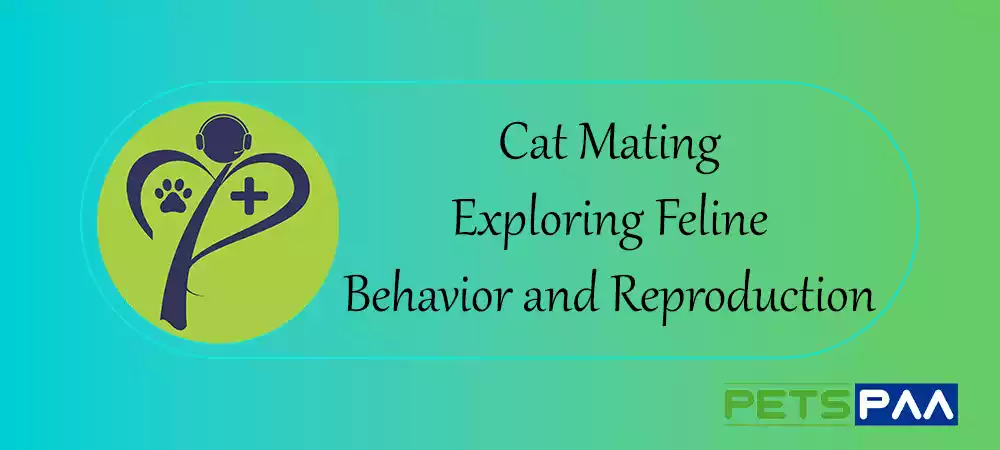We at PetsPaa understand that our feline friends are not always the most vocal creatures. While they meow and purr, they rely primarily on body language to express their feelings and their intentions. Reading your cat’s body language can help you better understand them and strengthen your bond.
In this guide, we will discuss the meaning of various cat body language cues and how you can interpret them to better understand your cat’s behavior and needs.
Table of Contents
Introduction
Almost every pet owner wishes to better understand their furry friends. Reading your feline friend’s body language is especially important for cat owners because cats are less vocal than other pets. We at PetsPaa understand the importance of being able to interpret your cat’s mood and intentions through body language cues.
Cats express their feelings and intentions through a variety of body language cues. Understanding these cues can help you strengthen your bond with your cat and respond to their needs appropriately. A puffed-up tail, for example, can indicate fear or aggression, whereas a relaxed body posture and half-closed eyes usually indicate contentment and relaxation. By observing a cats body language in various situations, you can gain a better understanding of their personality and unique qualities.
At PetsPaa, we consider it important to recognize and care for each individual pet. Whether you’re a new cat owner or have been living with felines for years, this guide will help you provide the best possible care and build a stronger bond with your furry friend. So, let’s explore the fascinating world of cat body language together!
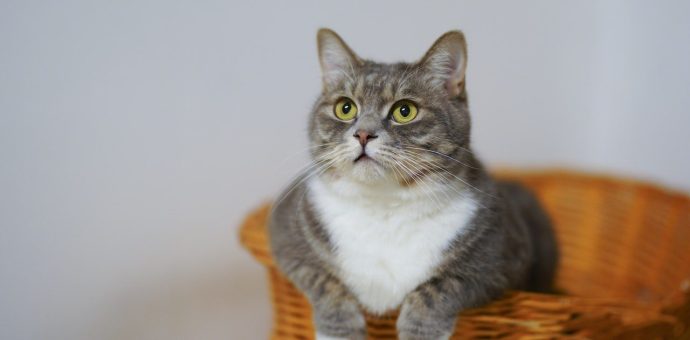
Cat Body Language Meaning
Cats communicate their feelings and intentions through a variety of body language cues. Here are some common types:
Tail
- Twitching or flicking tail: Indicates agitation or annoyance.
- Puffed up tail: Indicates fear or aggression.
- Curved tail with the tip pointing upwards: Indicates a friendly greeting.
- Tail tucked between legs: Indicates fear or submission.
Ears
- Ears forward: Indicates curiosity or alertness.
- Ears flattened against the head: Indicates fear or aggression.
- Ears slightly back: Indicates relaxation or contentment.
Eyes
- Dilated pupils: Indicates fear, excitement, or aggression.
- Slow blinking: Indicates relaxation and trust.
Body
- Arched back with fur standing up: Indicates fear or aggression.
- Crouched low to the ground: Indicates fear or submission.
- Relaxed and loose body: Indicates relaxation and contentment.
Read More >> Healthy Cat Signs: Your ABC Guide to Feline Wellness
How to Read Cat Body Language?
Understanding cat body language is more complex and difficult. It requires close observation, patience, and a deep understanding and knowledge of your cat’s personality and behavior. Here we are sharing some tips to read your cat’s body language:
- Start observing your cat’s body language in various situations, such as when they are relaxed, playing, or interacting with other cats or people.
- Pay attention to the context of the body language cues. For example, a puffed-up tail may indicate fear in one situation and aggression in another.
- Look for additional cues, such as vocalizations and facial expressions, to confirm your interpretation.
- Be patient and give your cat space if they seem agitated or uncomfortable.
- Watch your cat’s body and tail movements. A relaxed tail is low and still, while a tense tail may twitch or shoot up.
- Notice your cat’s facial expressions. Open eyes and ears indicate interest, while closed eyes and ears indicate the opposite.
- Notice changes in your cat’s meowing. A higher pitch or increased frequency often signals agitation.
- Look out for other signs, such as dilated pupils, fur standing on end, or hackles raised. These signals mean your cat is feeling threatened.
- Be observant of your cat’s posture. A relaxed cat may be lying down with all four paws tucked in, while an anxious one may sit with its tail tucked between its legs.
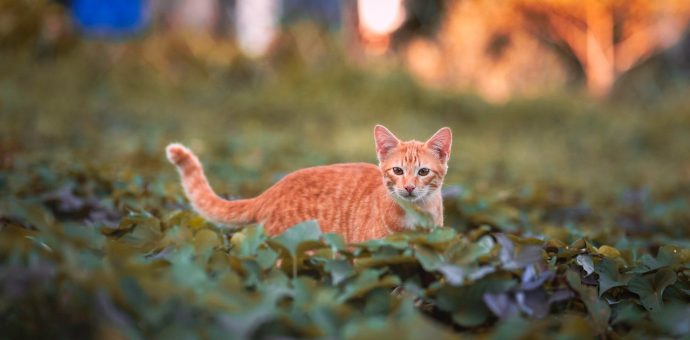
Cat Body Language Chart
While there is no definitive cat body language chart, here is a basic guide to some common cues:
- Tail twitching or flicking: Agitation or annoyance.
- Puffed up tail: Fear or aggression.
- Curved tail with tip pointing upwards: Friendly greeting.
- Tail tucked between legs: Fear or submission.
- Ears forward: Curiosity or alertness.
- Ears flattened against the head: Fear or aggression.
- Ears slightly back: Relaxation or contentment.
- Dilated pupils: Fear, excitement, or aggression.
- Slow blinking: Relaxation and trust.
- Arched back with fur standing up: Fear or aggression.
- Crouched low to the ground: Fear or submission.
- Relaxed and loose body: Relaxation and contentment.
Cat Body Language | Meaning |
Tail twitching or flicking | Agitation or annoyance |
Puffed up tail | Fear or aggression |
Curved tail with tip pointing upwards | Friendly greeting |
Tail tucked between legs | Fear or submission |
Ears forward | Curiosity or alertness |
Ears flattened against the head | Fear or aggression |
Ears slightly back | Relaxation or contentment |
Dilated pupils | Fear, excitement, or aggression |
Slow blinking | Relaxation and trust |
Arched back with fur standing up | Fear or aggression |
Crouched low to the ground | Fear or submission |
Relaxed and loose body | Relaxation and contentment |
Cat Signs Language
Cats communicate using a variety of vocalizations and facial expressions. Here are some suggestions:
Vocalizations
- Meowing: A greeting, request for attention, or indication of distress.
- Purring: Indicates relaxation and contentment.
- Hissing: Indicates fear or aggression.
- Chattering or trilling: Indicates excitement or anticipation.
Facial Expressions
- Blinking or squinting: Indicates relaxation and trust.
- Staring or wide-eyed: Indicates fear or aggression.
- Slowly closing eyes: Indicates contentment and relaxation.
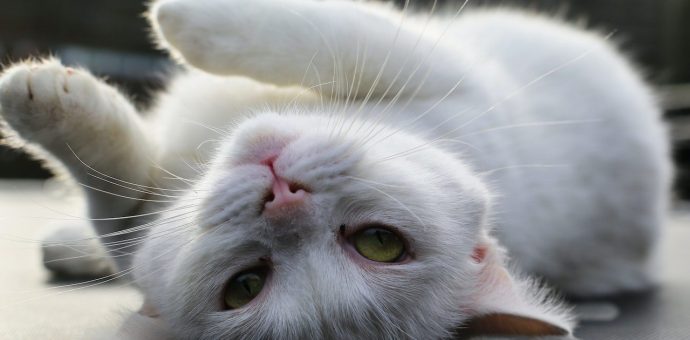
Happy Cat Body Language
A happy cat will exhibit several signs of contentment and relaxation. Some of the most common happy cat body language signals include:
- Relaxed body posture: A happy cat will have a relaxed, loose body posture. They will not be tense or on guard.
- Eyes: A happy cat’s eyes will be half-closed or fully closed, indicating contentment and relaxation.
- Purring: Purring is a clear sign of a happy cat. It usually means they are relaxed and content.
- Kneading: Kneading is another sign of a happy cat. They will knead with their front paws, usually on a soft surface, like a blanket.
Angry Cat Posture or Angry Cat Body Language
An angry cat is easy to spot if you know how to judge. Here are some of the most common angry cat body language signals:
- Ears: The ears of an angry cat will be flat against their head.
- Tail: The tail of an angry cat will be puffed up, indicating agitation or fear.
- Hissing and growling: are clear indications of an agitated cat. They are intended to intimidate and deter potential threats.
- Arched back: An angry cat will frequently arch their back, making themselves appear larger and more intimidating.
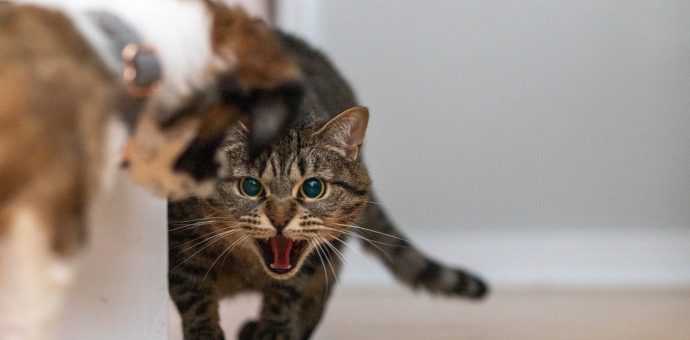
Sick Cat Body Language
When a cat is not feeling well, they may exhibit some of the following body language signals:
- Grooming: Sick cats may neglect to groom, resulting in a ragged appearance.
Lethargy: A sick cat may appear lethargic or depressed and be less active than usual.
Hiding: A sick cat may seek refuge away from their usual social areas.
Loss of appetite: If a cat is not feeling well, they may lose appetite and refuse to eat.
If you notice any of these symptoms, show your pet to the vet for a checkup.
Cat Body Language Tail
The tail of a cat can reveal a lot about their mood and attitude. Below are several examples of common tail positions and what they mean:
- Upright: A cat with an upright tail is confident and alert.
- Straight out: A cat with a straight-out tail is excited and curious.
- Puffed-up tail: Fear or aggression is indicated by a puffed-up tail.
- Tucked under: A cat with its tail tucked under its body is afraid or submissive.
Cat Body Language Ears
A cat’s ears also reveal a lot about their mood and attitude. Here we are listing some most common ear positions with their mean:
- Forward: Forward-facing ears indicate that a cat is alert and interested.
- Flat against the head: Flat against the head ears indicates fear or aggression.
- Slightly back: Slightly back ears indicate that a cat is relaxed and comfortable.
- Pinned back ears: Pinned back ears indicate that a cat is nervous or aggressive.

How do you know if a cat doesn't like you?
There are several signs that a cat may exhibit if a cat don’t like you:
- Hiding: If a cat avoids and hides from you constantly, it indicates that they don’t feel secure around you.
- Hissing or growling: These signs indicate that the cat perceives you as a threat.
- Swishing tail: A cat’s tail twitching or swishing back and forth rapidly may indicate agitation or frustration.
- Flattened ears: If a cat’s ears are pressed flat against their head, it indicates that they are scared or angry.
- Scratching or biting: If a cat scratches or bites you, they are probably feeling threatened or uncomfortable around you.
Conclusion:
In conclusion, understanding your cat’s body language can be essential in strengthening your bond with them. At PetsPaa, we acknowledge that cats primarily rely on body language to express their feelings and intentions. Knowing what your cat’s body language cues mean can help you respond to their needs and understand their personality better.
At PetsPaa, we believe that every pet deserves to be understood and cared for. As a cat owner, start observing your cat’s body language, keep close eyes on the signs exhibited, and be patient with them. With the insights in this guide, you may better interpret and comprehend your cat’s body language and develop a deeper and stronger bond with your feline companions.
With this guide, you’ll be well on your way to understanding your cat’s unique way of communicating with you. Happy decoding from Team PetsPaa!


